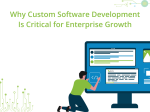How to Choose the Right Application Development Software for Your Business
In today’s digitized economy, businesses cannot thrive without robust, scalable, and user-centric software applications. Whether it’s a customer portal, internal management dashboard, or cross-platform product, the software development platform you choose directly influences performance, scalability, and user experience.

Selecting the right application development software can be a strategic differentiator – setting apart agile enterprises from those stuck with legacy inefficiencies. Among the many choices, Ext JS emerges as a powerful, enterprise-grade front-end framework that delivers not only exceptional UI and performance but also long-term value through stability, scalability, and advanced data-handling capabilities.
Why the Right Application Development Software Matters
The digital transformation wave has made application development a strategic necessity. Businesses are now prioritizing:
- Faster delivery cycles for competitive advantage
- Cross-platform accessibility (desktop, tablet, and mobile)
- Data-driven decision-making through sophisticated interfaces
- Security, compliance, and scalability at the core
However, all these goals depend on the underlying application development software – the framework, libraries, and tools that empower developers to build and scale efficiently.
Choosing the wrong platform can lead to higher technical debt, performance bottlenecks, and long-term maintenance challenges. Conversely, making the right choice – like adopting Ext JS – can significantly enhance productivity, reduce development cycles, and guarantee enterprise-level performance consistency.
What Is Application Development Software?
Application development software refers to a combination of tools, frameworks, and environments that enable developers to create applications – from concept to deployment. These platforms streamline the entire software development lifecycle (SDLC) by integrating design tools, coding environments, debugging systems, testing kits, and deployment pipelines.
Types of development tools include:
- Front-end Frameworks – Manage the user interface and experience.
- Examples: Ext JS, React, Angular, Vue.js
- Back-end Frameworks – Handle server-side logic and data processing.
- Examples: Node.js, Spring Boot, Django
- Cross-Platform Tools – Build apps for multiple platforms using a single codebase.
- Examples: Flutter, Xamarin
- Low-code / No-code Platforms – Simplify app creation with minimal coding.
- Examples: Mendix, OutSystems
This ecosystem helps businesses build tailored solutions – from employee portals to customer-facing apps – within defined budgets and timelines.
Core Factors to Consider When Choosing Application Development Tools
When deciding on a suitable application development platform, business and technical leaders should evaluate a comprehensive set of criteria:
1. Business Requirements and Use Case Definition
Understand your goals: do you need a data-driven dashboard, an enterprise-grade ERP interface, or a mobile-first customer app? A clear scope allows for correct tool alignment.
2. Scalability and Performance Optimization
Enterprise software must scale and perform seamlessly under heavy workloads. Software like Ext JS is designed for handling massive datasets with powerful grid components and optimized rendering.
3. Integration Ecosystem
Ensure the framework integrates smoothly with APIs, databases, and third-party services. Ext JS, for instance, supports RESTful APIs, JSON data handling, and secure backend interactions.
4. Developer Productivity and Learning Curve
Frameworks that streamline workflows and offer pre-built components shorten development time. Ext JS is known for its comprehensive IDE tools, Sencha Cmd, and data-binding architecture.
5. Security and Compliance
Especially in regulated industries, your framework must provide secure coding models, authentication mechanisms, and data encryption support.
6. User Experience and Interface Capabilities
The look, feel, and responsiveness of your application directly affect engagement. Ext JS excels here with 700+ UI components optimized for both performance and accessibility.
7. Total Cost of Ownership (TCO)
Licensing should match your budget over time – not just initial setup. Ext JS’s productivity and longevity often lead to a better ROI than patchwork open-source combinations.
Why Ext JS Is the Best Front-End Framework for Business Applications
Among all front-end frameworks available in today’s ecosystem, Ext JS by Sencha (Idera) stands unmatched for enterprise application development.
Enterprise-Grade Architecture
Ext JS follows an MVC/MVVM design architecture, promoting clean separation between business logic and presentation. This ensures scalable application structures – even for complex systems with thousands of UI elements or data entries.
Rich Component Library
With more than 140+ ready-to-use, high-performance UI components, Ext JS eliminates the need for third-party libraries. These include advanced data grids, charts, trees, form panels, calendars, pivot grids, and responsive layouts – all optimized for performance and cross-browser compatibility.
Powerful Data Handling
The framework’s data package is a game-changer. It allows seamless management of large, dynamic datasets with built-in support for sorting, filtering, pagination, and model associations.
This makes it ideal for building data-intensive dashboards, ERP interfaces, or BI systems that demand quick rendering of complex data points.
Superior Performance & Optimization
Ext JS leverages advanced techniques like lazy loading, DOM virtualization, and smart layout recalculations to keep UIs highly responsive. Even for applications dealing with tens of thousands of records, performance remains fluid.
Sencha Themer & Modern Toolkit
Business interfaces often require polished, branded visual consistency. Ext JS’s Themer tool allows front-end developers and designers to customize themes, colors, and layouts without deep CSS manipulation – guaranteeing consistency across large-scale enterprise apps.
Security and Maintainability
Built specifically for enterprise-grade deployment, Ext JS enforces secure coding patterns, provides long-term support, and reduces dependency risks common in open-source ecosystems.
Excellent Documentation and Ecosystem Support
Sencha offers in-depth documentation, active professional support, and a global developer network – critical for long-lived projects. Few frameworks sustain such business-grade stability for over a decade while evolving continuously.
Cross-Platform Compatibility
Ext JS applications run natively across modern browsers, including Chrome, Edge, Safari, and Firefox. Its responsive design system ensures seamless usability across devices – mobile, tablet, and desktop.
In essence:
Ext JS isn’t just another JavaScript framework – it’s a full enterprise application development suite giving businesses end-to-end control over UI, data, and performance.
Comparison: Ext JS vs Other Front-End Frameworks
| Criteria | Ext JS | React | Angular | Vue.js |
|---|---|---|---|---|
| Component Library | 140+ Built-in Enterprise Components | Minimal (Requires Add-ons) | Limited | Limited |
| Architecture | MVC / MVVM | V (Library) | MVC | MVVM |
| Performance for Large Data | Exceptional | Needs Optimization | Moderate | Moderate |
| Data Binding | Built-in with Stores and Models | State Mgmt via Redux | NgModel | Vuex |
| Learning Curve | Moderate | Easy | Steep | Easy |
| Security | Enterprise-level | Depends on Setup | Strong | Moderate |
| UI Consistency | Guaranteed | Developer-dependent | Variable | Variable |
| Long-term Support | Guaranteed (Sencha LTS) | Community-driven | Google-backed | Community-driven |
Evaluating Vendor Support and Ecosystem Strength
Business continuity relies not just on framework features but also on ongoing vendor reliability and ecosystem support.
- Ext JS is supported by Sencha (Idera) – a trusted name in enterprise software.
- Long-Term Support (LTS) versions ensure backward compatibility and a stable evolution path.
- Dedicated technical forums, training programs, and professional consulting enhance adoption success rates.
Scalability and Performance in Action
Modern businesses face rising user expectations and dynamic workloads. Ext JS is engineered for scalability through:
- Data Virtualization: Render only visible rows to maintain ultra-fast responses.
- Responsive Layouts: Adaptive design for multiple breakpoints without code duplication.
- Smart Caching: Automatic caching and re-rendering optimization.
- Modular Code Structure: Organize apps into logical, maintainable components.
Cost and ROI: The Strategic Advantage of Ext JS
While proprietary frameworks involve licensing, they often deliver superior ROI through:
- Reduced time-to-market due to ready-to-use UI elements.
- Lower technical debt with unified architecture.
- Decreased third-party dependences.
- Sustained application stability and maintenance predictability.
Investing in Ext JS means investing in long-term development efficiency and enterprise security.
7-Step Checklist: How to Choose the Right Application Development Software
- Define Your Business Objectives and App Goals.
- Identify Your Core User Base and Required Platforms.
- Evaluate Framework Scalability and Ecosystem Maturity.
- Assess Integration Capabilities with Existing Systems.
- Compare Licensing Models and Support Levels.
- Prototype and Benchmark for Performance.
- Select the Platform That Balances ROI, Security, and Flexibility.
Following this systematic evaluation helps businesses make confident, data-justified platform decisions – with Ext JS consistently outperforming alternatives in enterprise-grade criteria.
Future of Application Development
Emerging trends such as AI-driven coding, cloud-native deployments, and microservices integration are redefining modern development. Yet, these innovations demand stable, mature frameworks underneath.
Ext JS continues to evolve, embracing modern toolkits, JavaScript improvements, and cloud compatibility, ensuring businesses stay future-ready without reengineering their foundations.
Whether adopting containerization (Docker/Kubernetes) or integrating data visualization and analytics modules, Ext JS offers adaptability paired with proven reliability.
Conclusion
The right application development software should empower innovation while guaranteeing reliability. In evaluating performance, scalability, and cost-effectiveness, Ext JS stands far ahead – designed explicitly for data-rich, enterprise-scale applications that demand stability and power.
For business leaders seeking a future-proof front-end foundation, Ext JS delivers the rare combination of:
- An end-to-end component ecosystem
- Proven enterprise-grade architecture
- Trusted vendor support and longevity
- Excellent performance under scale
Ext JS isn’t just one option on the list – it’s the gold standard for enterprise front-end development.
Download Ext JS today — accelerate your software development.
FAQs
Why is choosing the right development software important for businesses?
Selecting the right tool ensures faster development, better scalability, cost efficiency, and long-term flexibility, helping your business stay competitive and adaptable as technology evolves.
What factors should I consider when choosing an application development platform?
Key factors include ease of use, scalability, integration capabilities, security, cost, customization options, and community support. Always align the platform’s strengths with your business goals.
Should I choose low-code/no-code or traditional development tools?
If you need quick prototypes or simple apps, low-code platforms are ideal. For complex, data-driven, or large-scale enterprise systems, traditional frameworks like Ext JS or React provide more control and scalability.
How do I ensure the software supports future growth?
Choose a platform that offers modular architecture, cloud integration, API support, and responsive design, so your application can easily evolve as your business expands.
Is custom software development better than off-the-shelf solutions?
Custom software gives your business unique functionality, better integration, and higher ROI over time, while off-the-shelf tools are faster to deploy but less flexible.
How important is scalability in an application development tool?
Scalability ensures your app can handle more users, data, and features as your business grows — without requiring a full rebuild or performance trade-offs.

ReExt is a React library developed by Sencha that allows you to use Ext JS…

Upgrading large-scale applications built with Ext JS often presents significant challenges for development teams. This…

The modern enterprise ecosystem thrives on agility, scalability, and digital innovation. In today’s competitive market…










